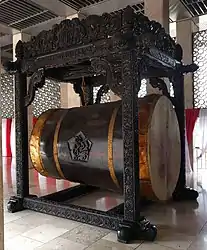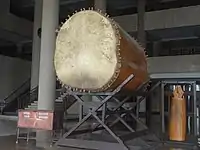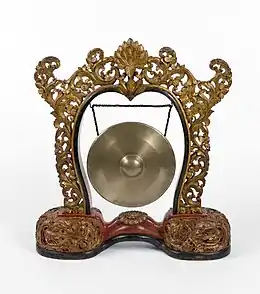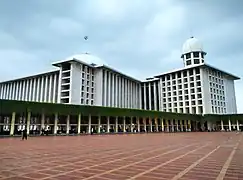Bedug
The bedug (Indonesian and Malaysian Malay: beduk; Javanese: bedhug; Sundanese: dulag) is one of the drums used in the gamelan. It is also used among Muslims in Indonesia and Malaysia[1] to signal mosque prayer times.[2][3] The hitting of the instrument is particularly done according to a rhythm that goes in an increasingly rapid (or accelerando) pace.[1]
 A bedug in Istiqlal mosque, Jakarta. | |
| Percussion instrument | |
|---|---|
| Other names | Beduk, Bedhug |
| Classification | Membranophone |
| Hornbostel–Sachs classification | 211.212.1 (Cylindrical drum) |
| Developed | maritime Southeast Asia |
Overview
A bedug is a large double-headed drum[2] with water buffalo or cow leather on both ends.[3][1]
Unlike the more frequently used kendang, the bedug is suspended from a frame and played with a padded mallet. The bedug is as large as or larger than the largest kendang and generally has a deeper and duller sound. The drum has pegs holding the two identical heads in place, similar to the Japanese taiko, and its pitch is not adjustable.
Usage

The bedug is not used in most gamelan performances, although it is included in some Yogyakarta kendang styles. It is used in special ensembles such as the gamelan sekaten, where it takes the place of the kempul.[4] In some pieces it is played along with the kendang, especially to accompany dancing.
The bedug is commonly used in mosques in Java among Javanese and Sundanese people to precede the adhan as a sign for prayer[5] or during Islamic festivals.[2] For example, the sound of a bedug is used to signal the end of the day-long fast during Ramadan and sometimes it is used to signal time for Suhoor during Ramadan.[6] When used to signal time for Friday prayer, the bedug is beaten in a different way than for ordinary prayers.[3]
The bedug is also used to celebrate takbiran, the night before Eid ul-Fitr followings chants of takbir.
The tradition is also known among Sarawakian Malays who know it by the name teter.[7]
Among the Muslim Maranao people of the southern Philippines, a similar and smaller drum is used for announcing prayer times, known as the tabu or tabo.[8]
References
- "Beduk". National Arts and Cultural Department. Ministry of Tourism, Culture and Arts Malaysia. Archived from the original on 2017-02-14. Retrieved 15 May 2021.
- Rasmussen, Anne K. (2010). Women, the Recited Qur'an, and Islamic Music in Indonesia. University of California Press. ISBN 978-0-520-25549-4.
- Muhaimin, Abdul Ghoffir (2006). The Islamic traditions of Cirebon: ibadat and adat among Javanese Muslims. ANU E Press. ISBN 978-1-920942-30-4.
- Lindsay, Jennifer. Javanese Gamelan. Oxford: Oxford UP, 1979. ISBN 0-19-580413-9. Page 47.
- George, Kenneth M. (2010). Picturing Islam: Art and Ethics in a Muslim Lifeworld. John Wiley and Sons. p. 77. ISBN 978-1-4051-2957-2.
- "Celebrating the Fasting month of Ramadan and Lebaran in Indonesia". Expat.or.id. Retrieved 20 April 2021.
- "Teter beduk amalan tradisi Melayu Sarawak". Astro Awani. 9 May 2021. Archived from the original on 2021-05-15. Retrieved 15 May 2021.
- "Maranao Drum (Tabu)". National Museum Collections. Archived from the original on 28 June 2021. Retrieved 28 June 2021.
External links
- NIU site on the bedug, with illustration Archived 2020-02-25 at the Wayback Machine
- Virtual Instrument Museum Archived 2015-02-24 at the Wayback Machine




